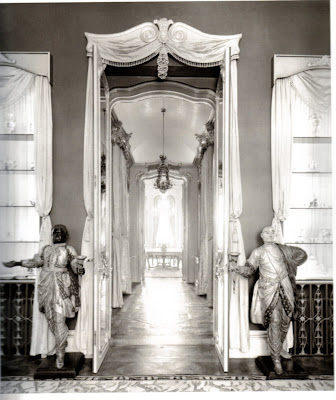
For those of you who have read any books chronicling 20th c. society, you have probably come across the name Chips Channon. Channon was an American whose sole focus in life was to climb his way up the ladder of British society. After attending Oxford, he fortuitously married Lady Honor Guinness; it was a match that made Channon a well-known figure in British and European society. While Channon is best known for his diaries that were published after his death, he was also much admired for his taste and refinement. In fact, he wrote in his diary that he was "rivetted by lust, furniture, glamour and society and jewels."
In 1935, Channon decided to decorate the dining room in his home on Belgrave Square, and he knew that he wanted to create the most beautiful room in London. To achieve this, he turned to Stephane Boudin of Maison Jansen. According to the recently published book Jansen
Boudin was not restrained in his design. He chose an aquamarine color for the walls. The walls were then adorned with plaster scrollwork, shells, birds, and other decorative motifs that had been silver-leafed. Adding to the shimmery effect were mirrors and mirrored double doors. The design of the furniture was just as exuberant. The silvery, Rococo dining table was topped by squares of mirror. The curvy chairs were silver-leafed as well, and their cushions were covered in aquamarine silk damask. This material was also used for the curtains in the room.
Interestingly, Boudin knew that with such a dazzling room there needed to be a "transitional" space that would prepare a guest for such splendor. He designed two rooms that led to the magnificent dining room: a smaller, intimate dining room and a narrow hall. The small dining room was painted black, and because there were no windows in this room, he designed display cases that were made to look like windows. In these illuminated cases were displayed the Channons' collection of 18th c. porcelain. The hallway that connected both dining rooms was painted apricot and decorated with silver-leaf plasterwork, although on a much smaller scale than that of the dining room. The design of the hallway certainly indicated a "great" room ahead.
Once these rooms were completed, they were talk of London. The collaboration between Boudin and Channon was mutually beneficial- Channon secured his place in London society as well as his role as an aesthete, and Boudin and Maison Jansen gained the reputation as one of the foremost decorators and decorating firms in Europe.

Images above of the Channon Dining Room courtesy of Jansen
 Image of the Channon Intimate Dining Room leading into Hallway, courtesy of Jansen
Image of the Channon Intimate Dining Room leading into Hallway, courtesy of JansenView of the Hall of Mirrors at Amalienburg








No comments:
Post a Comment